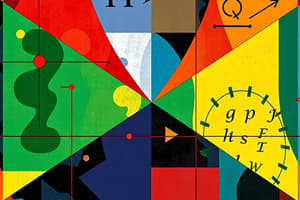Podcast
Questions and Answers
What do DeMorgan's theorems help with in Boolean algebra?
What do DeMorgan's theorems help with in Boolean algebra?
- Finding the greatest common divisor
- Solving quadratic equations
- Simplifying expressions with inverted variables (correct)
- Calculating prime numbers
According to DeMorgan's Theorem (16), what is the equivalent of inverting the OR sum of two variables?
According to DeMorgan's Theorem (16), what is the equivalent of inverting the OR sum of two variables?
- Inverting each variable individually and then adding them
- Inverting each variable individually and then ORing them
- Inverting each variable individually and then multiplying them
- Inverting each variable individually and then ANDing them (correct)
What is the equivalent of inverting the AND product of two variables according to DeMorgan's Theorem (17)?
What is the equivalent of inverting the AND product of two variables according to DeMorgan's Theorem (17)?
- Inverting each variable individually and then adding them
- Inverting each variable individually and then ORing them (correct)
- Inverting each variable individually and then ANDing them
- Inverting each variable individually and then multiplying them
How can DeMorgan's theorems be applied when x and y are expressions containing more than one variable?
How can DeMorgan's theorems be applied when x and y are expressions containing more than one variable?
When applying DeMorgan's Theorem (16), which expression can be simplified using ANDing of inverted variables?
When applying DeMorgan's Theorem (16), which expression can be simplified using ANDing of inverted variables?
What is the result of applying DeMorgan's Theorem (17) to the expression (xy)'?
What is the result of applying DeMorgan's Theorem (17) to the expression (xy)'?
What is the result of applying DeMorgan's Theorem (16) to the expression (A + B)?
What is the result of applying DeMorgan's Theorem (16) to the expression (A + B)?
Using DeMorgan's Theorem (17), what is the equivalent of inverting the AND product of two variables A and B?
Using DeMorgan's Theorem (17), what is the equivalent of inverting the AND product of two variables A and B?
Using DeMorgan's Theorem (16), what is the simplified form of the expression (AB + C)'?
Using DeMorgan's Theorem (16), what is the simplified form of the expression (AB + C)'?
How can DeMorgan's Theorems be extended to more than two variables?
How can DeMorgan's Theorems be extended to more than two variables?
What is the output of a NOR gate with inputs x and y, as per theorem (16) of DeMorgan's Theorems?
What is the output of a NOR gate with inputs x and y, as per theorem (16) of DeMorgan's Theorems?
According to DeMorgan's Theorems, what can be applied to reduce an expression?
According to DeMorgan's Theorems, what can be applied to reduce an expression?
What does DeMorgan's Theorem (17) state about inverting an AND product?
What does DeMorgan's Theorem (17) state about inverting an AND product?
What is the equivalent of inverting the expression (x + y) according to DeMorgan's Theorem (16)?
What is the equivalent of inverting the expression (x + y) according to DeMorgan's Theorem (16)?
When using DeMorgan's Theorems, how can a large inverter sign be broken down?
When using DeMorgan's Theorems, how can a large inverter sign be broken down?
If y = AD + ABD, how can this expression be simplified using DeMorgan's Theorems?
If y = AD + ABD, how can this expression be simplified using DeMorgan's Theorems?
Flashcards are hidden until you start studying
Study Notes
DeMorgan's Theorems in Boolean Algebra
- DeMorgan's theorems help in simplifying Boolean algebra expressions by breaking down complex statements into simpler ones.
- The equivalent of inverting the OR sum of two variables is the AND product of their inverses, i.e.,
(x + y)' = x' y'. - The equivalent of inverting the AND product of two variables is the OR sum of their inverses, i.e.,
(xy)' = x' + y'. - DeMorgan's theorems can be applied to expressions containing more than two variables by recursively breaking down the expressions into smaller ones.
- The expression
(x' y')'can be simplified using ANDing of inverted variables. - Applying DeMorgan's Theorem (17) to the expression
(xy)'results inx' + y'. - Applying DeMorgan's Theorem (16) to the expression
(A + B)results inA' B'. - The equivalent of inverting the AND product of two variables A and B is
A' + B'. - The simplified form of the expression
(AB + C)'isA' B' + C'. - DeMorgan's Theorems can be extended to more than two variables by recursively applying the theorems.
- The output of a NOR gate with inputs x and y is
x' y', as per DeMorgan's Theorem (16). - DeMorgan's Theorems can be applied to reduce an expression by breaking down complex statements into simpler ones.
- DeMorgan's Theorem (17) states that inverting an AND product is equivalent to the OR sum of their inverses.
- The equivalent of inverting the expression
(x + y)isx' y'. - A large inverter sign can be broken down into smaller ones using DeMorgan's Theorems.
- The expression
y = AD + ABDcan be simplified using DeMorgan's Theorems by breaking down the expression into smaller ones.
Studying That Suits You
Use AI to generate personalized quizzes and flashcards to suit your learning preferences.




